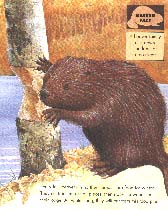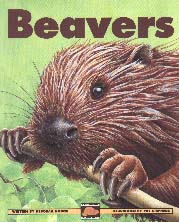|
________________
CM . . . .
Volume VII Number 1 . . . . September 8, 2000
excerpt: Beaver food  Beavers is a superb example of a well-written information book for pre-readers which will also
appeal to students in the early elementary grades. Despite its picture book length, Beavers
contains features normally associated with longer works of nonfiction: a well crafted table of
contents, a useful glossary and a serviceable index. The book's contents are organized into 13
pairs of facing pages which each deal with a single topic relating to beavers. These pages move
from general information about beavers, such as their being rodents and their worldwide
distribution (supported by a map), to more specific topics such as beaver food, bodies, lodges and
dams. Adding greatly to the book's information value are Pat Stephens' colour illustrations which
concretize the text's facts. Particularly effective are her cross sections of a beaver dam and lodge
and her four panels which show how a dam is constructed. The book is well designed with most
spreads containing a major text section, a principal illustration and further smaller secondary
illustrations which are supported by briefer text. Eight of the paired pages also contain a "Beaver
Fact" box which drops in tidbits of information, such as the fact that "millions of years ago...some
[beavers] were as large as bears" or that "a beaver can stay underwater for up to 15 minutes."
Closing pages show how, in nature, beavers' dams ultimately contribute to the creation of lush
meadows, but Hodge also candidly acknowledges that the beavers' work in urban or farm areas
can create problems of flooding for humans. A concluding page, "Beaver signs," provides five
visual means by which readers can recognize the presence of beavers in the readers' locale. A
portion of this page includes Stephens' life-sized illustrations of a beaver's front and back paw
prints.
Beavers is a superb example of a well-written information book for pre-readers which will also
appeal to students in the early elementary grades. Despite its picture book length, Beavers
contains features normally associated with longer works of nonfiction: a well crafted table of
contents, a useful glossary and a serviceable index. The book's contents are organized into 13
pairs of facing pages which each deal with a single topic relating to beavers. These pages move
from general information about beavers, such as their being rodents and their worldwide
distribution (supported by a map), to more specific topics such as beaver food, bodies, lodges and
dams. Adding greatly to the book's information value are Pat Stephens' colour illustrations which
concretize the text's facts. Particularly effective are her cross sections of a beaver dam and lodge
and her four panels which show how a dam is constructed. The book is well designed with most
spreads containing a major text section, a principal illustration and further smaller secondary
illustrations which are supported by briefer text. Eight of the paired pages also contain a "Beaver
Fact" box which drops in tidbits of information, such as the fact that "millions of years ago...some
[beavers] were as large as bears" or that "a beaver can stay underwater for up to 15 minutes."
Closing pages show how, in nature, beavers' dams ultimately contribute to the creation of lush
meadows, but Hodge also candidly acknowledges that the beavers' work in urban or farm areas
can create problems of flooding for humans. A concluding page, "Beaver signs," provides five
visual means by which readers can recognize the presence of beavers in the readers' locale. A
portion of this page includes Stephens' life-sized illustrations of a beaver's front and back paw
prints.
A most useful addition to school libraries, Beavers should also be read to the two-legged Beavers in the "Beaver" section of Scouts Canada. Highly Recommended. Dave Jenkinson, who teaches courses in children's and adolescent literature in the Faculty of Education, University of Manitoba, also lives near the LaSalle River which is home to many four-legged beavers.
To comment on this title or this review, send mail to cm@umanitoba.ca.
Copyright © the Manitoba Library Association.
Reproduction for personal use is permitted only if this copyright notice
is maintained. Any other reproduction is prohibited without
permission.
Published by
TABLE OF CONTENTS FOR THIS ISSUE - September 8, 2000.
AUTHORS |
TITLES |
MEDIA REVIEWS |
PROFILES |
BACK ISSUES |
SEARCH |
ORDER |
CMARCHIVE |
HOME
|
